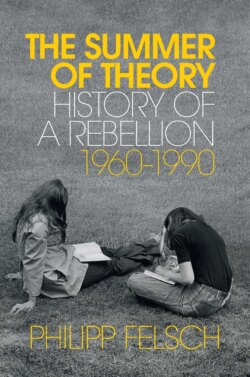Читать книгу The Summer of Theory - Philipp Felsch - Страница 19
New Leftists
ОглавлениеThe lines of conflict of debates to come were already laid out in that statement. But in the autumn semester of 1965, Adorno’s affirmation of pure philosophy must have been met with approval in the ranks of the New Left. If the seed Adorno had sown yielded such an abundant harvest in the sixties, it was thanks to the enthusiasm for culture among Germans born in wartime, as well as to the rise of the first theory generation.3 In 1959, the Social Democratic Party (SPD) had adopted the Godesberg Programme, abandoning the goal of overcoming rather than reforming capitalism, and in 1961, it declared the new political course irreconcilable with the aims of its former youth organization, the Socialist German Student League (SDS), and cut off its financial support. This push-off into precarity – which would soon be cushioned by new funding for the SDS from East Germany – marked the beginning of the history of the New Left in Germany. Left in the lurch by their mother organization, the students turned their backs on the dogmas of Social Democratic folklore, sized up the conformism of the West German proletariat and, making a virtue out of necessity, rolled up their sleeves as revolutionary subjects. Thus, the early sixties saw the formation of the ‘student movement’, so named in analogy to the ‘labour movement’. The distinguishing characteristic that set it apart from the classical left – especially in West Germany – was theory.4
‘What is to be done?’ cried the literature student Elisabeth Lenk at the 17th regular delegates’ conference of the SDS in October 1962. Her answer to Lenin’s famous question: work on theory. In the face of union officials who proudly claimed not to read books, in the face of a Social Democratic Party that was throwing itself at the petite bourgeoisie, the path of the New Left must lead into the vineyard of texts. Lenk urgently warned her comrades against the casual cultural critique of the nonconformists, who ‘think they are performing a revolutionary act by sitting in a basement jazz bar with their Enzensberger haircuts’. The SDS needed hard, ‘socialist theory’. Lenk’s speech gives voice to the need for fundamental research of a kind that the Left had last undertaken in the 1920s. ‘But what is socialist theory?’ she asked her comrades. ‘Is it the same as unadulterated Marxism? Or is it a revised Marxism, and if so, which one? Bernstein’s, Kautsky’s, Lenin’s, or that of some Marxist-Existentialist? Or is it just the eclectic interconnection of handy bits of theory?’5
From this vantage, we can already see looming on the horizon the craggy ridge of text that the students of the coming years would have to climb. Under the eyes of these readers, the revolution metamorphosed into textual analysis.6 Until its creeping exhaustion, the Left’s theoretical discourse was dominated by a powerful fantasy of reprieve which looks startlingly similar to Adorno’s ‘breathing space’: there could be no revolution, according to the credo of these years, without a theory of revolution, which neither Marx nor his successors had supplied. And building such a theory would take longer than a five-year plan. The SDS ‘study groups’ proposed by Elisabeth Lenk were given relatively short deadlines. Hans-Jürgen Krahl, on the other hand, the intellectual head of Frankfurt’s anti-authoritarians, estimated in 1969 that it would take several decades to develop a theory of revolution.7 That was the same year, by the way, in which Niklas Luhmann at the University of Bielefeld estimated a development time of thirty years for his ‘theory of society’. After ’68, once the messianic expectations had been dispelled, theory developed staying power – and not just on the left. As the catalogue of available classics grew longer, the network of references denser and the political hopes more cloudy, the practice of difficult thinking transformed into a process whose end was hardly foreseeable.
